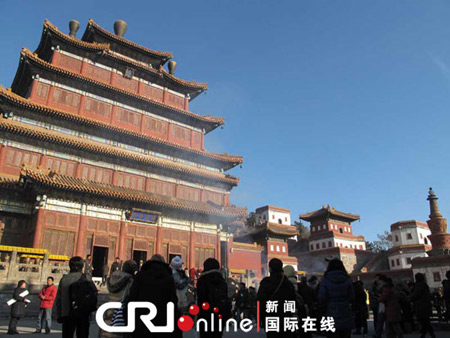Chengde: 'little Tibet' in north China
Tibet is attractive and charismatic for both Europeans and Chinese. However, it is still considered a luxury for many people to visit Tibet, known as the "Roof of the World." Besides, some people are extremely fearful of the thin air in the Himalayas.
Therefore, a trip to Chengde, a city in north China's Hebei Province and only 500 meters above sea level, is a new choice for many because they can spend much less money and need not to worry about their own health.
|
|
|
Chengde's Puning Temple, a replica of the Samye Temple beside Lhasa. [Photo: CRIonline] |
During the Qing Dynasty (between 1644 and 1911), a group of special temples called the Eight Outer Temples emerged on the gently rolling hills around the Chengde Mountain Resort.
They integrated the unique building techniques of the Han and Manchu people, as well as the Mongolians. The integration of different architectural styles symbolized the unification of China. The temples fully embody various ethnic characteristics. For example, Tibetan elements have been reflected by the Potaraka Doctrine Temple.
|
|
|
The Potaraka Doctrine Temple, an imitation of the Potala Palace in Lhasa. [Xinhua Photo] |
The Potaraka Doctrine Temple is an imitation of the Potala Palace in Lhasa. It is half the size of the palace in Lhasa and was built in 1771 to celebrate the 60th birthday of the Emperor Qianlong.
The magnificent temple astounds everyone. Its roof is made from pure gold and one can climb to it and look down at the surrounding beautiful scenery. Despite the fact that there are some flags and prayer wheels at the top, the nearby green hills will make anyone realize that they are in Hebei, and not remote Tibet.
Puning Temple means eternal peace. It was built based on the Samye Temple which is located beside Lhasa. Although there is no Tibetan butter tea and Buddhist devotees kneeling down to worship the Buddhas in the temple and the Potaraka Doctrine Temple, people there can still have the feeling that they are standing in Tibet.
The smell of the incense sticks and the monks in red robes reminded me of my trip in Tibet. The largest wooden Buddha statue in the world brought my spirit to a pure land for a month. It is so impressive that the world's strongest atheists would stand respectfully in front of it.
Chengde's architecture is not only derived from the Tibetan style but also from styles of other places. Emperors of the Qing Dynasty hoped they could realize the goal of national solidarity by copying architecture from different places in China, making everyone feel a sense of belonging, and use architecture to represent the unity of the country.
China has been much criticized for the problem of piracy for many years now. However, a story about Sven Anders Hedin (1865-1952) tells another story.
The famous Swedish scholar and inventor visited Chengde during a tour in Asia in the 1920s. He visited the Chengde Mountain Resort where ancient Chinese emperors went to avoid the heat. Entrusted by entrepreneur Vincent Bendix, Hedin sought to find a Lama temple in China to ship to Chicago in pieces. At last, he chose the Xumifushou Temple in Chengde, the imitation of the Tashilhunpo Monastery in Xigaze.
As local people refused to sell the temple to Hedin, he then decided to make life size replicas of the eight golden dragons on the top of the Xumifushou Temple. The imitation, called the Bendix Lama Temple, was finally transported to Chicago in 1933 and New York in 1939 for display at international exhibitions there.
Hedin had always hoped that his hometown could one day have a Chinese temple after he died, so Sweden can feel the Tibetan atmosphere that Chengde has.
 0 Comments
0 Comments









Comments